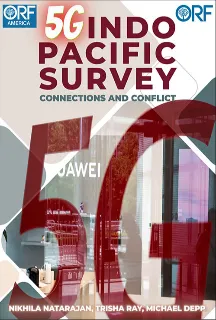5G will likely become one of the foundational technologies of the Fourth Industrial Revolution, enabling new applications in the realm of the Internet of Things (IoT), instant and seamless consumption of digital products and vastly improved connectivity for smart cities and smart factories. Two standout features—phenomenal speed and stunning reductions in latency—will separate current 4G/LTE networks from fifth generation networks (5G).
However, a hyper-connected world in a 5G embrace is ripe for cyberattacks at a scale never seen before, from simple household IoT devices to critical infrastructure like electricity grids and healthcare delivery systems. 5G will create unprecedented productivity but also bring unprecedented vulnerability. As Mike Burgess, Australia’s then-Director General of the Signals Directorate said in 2018, “Historically, we have protected the sensitive information and functions at the core of our telecommunications networks by confining our high-risk vendors to the edge of our networks. But the distinction between core and edge collapses in 5G networks. That means that a potential threat anywhere in the network will be a threat to the whole network.” It is precisely this calculus that makes 5G and the decision to use or not use certain vendors so uniquely polarising.
Today, nations are faced with the apparent binary of Chinese and Western technology. US president Joe Biden’s nominee for commerce secretary, Gina Raimondo, has made it clear that the new administration will not diverge from Donald Trump’s war-like resistance to Huawei both within the US and beyond. Such was the US’ battering ram style on this issue that in December 2019, Canada’s border agents arrested Huawei’s chief financial officer Meng Wanzhou at the request of the US—known in China as the company’s “princess”—as she changed planes in Vancouver.
In the first half of 2020, Huawei generated revenues of ~US $63 billion, up 13.1 percent from the same period a year earlier.3 The company was involved in 140 commercial 5G deployments across 59 countries. That business landscape is shifting. Samsung of South Korea, India’s Jio, and NTT Docomo in Japan are all betting on indigenous networks based on advanced software, off the shelf hardware and open standards.
The tech battle between the US and China has become a major setback for Huawei and torn into the well laid plans of companies—not just American—that produce and sell in China. Nearly half (47 percent) of the world’s chips are sold globally by US firms like Intel and Qualcomm. Beijing is now pouring resources into high-tech chips as it seeks to decouple from the US. It has already invested US $30 billion in its semiconductor companies. But decoupling is complicated. Huawei has not commented on its inventory, but analysts suggest that Huawei’s stockpile will last at best another year or two.
The backlash against Huawei’s 5G offerings came with unprecedented political attention in 2020 as global opinions about Xi Jinping’s China soured in the wake of its early mismanagement of the COVID-19 pandemic. At the same time, Beijing’s reach has grown even wider because of Huawei’s role as one of the world’s largest vendors of 5G technology. The Quad is reportedly looking to build upon a common approach to 5G, and in March 2021, leaders at the virtual Quad summit committed to launching a “critical- and emerging-technology working group to facilitate cooperation on international standards and innovative technologies of the future.”
This special report provides an overview of the 5G state of play across 17 countries, with an Indo-Pacific focus. The report covers the Quad, the nations of ASEAN, and Northeast Asia. All of these countries are in the process of rolling out/ building their 5G services and infrastructure, while refining their stance on how to deal with the vulnerabilities and geopolitical tensions they will necessarily inherit along the way.
The Indo-Pacific, home to some of most rapidly-growing digital economies in the world, will prove pivotal to the global 5G story.
Based on a variety of publicly available information and country policy documents, we rank each of these countries on a 1-5 scale along 5 parameters: National ban on Chinese 5G equipment, 5G readiness, Homegrown 5G, and, finally, legacy Chinese equipment from 2G/3G/4G. Readers of this report can also scroll through timelines which capture a range of government and corporate interventions specific to the Huawei issue. These range from tests and installations, policy moves, political wrangling and bans and exclusions.
Hardcoding safety into the system is on everyone’s mind, no matter where they stand on the arc between No way, Huawei and Huawei Strong.
Some countries have remained characteristically ambivalent, with Malaysia and Singapore emphasising their own security and quality standards, refusing to ban “certain vendors”, choosing instead to work with a mix of them—Huawei, ZTE, Nokia, Ericsson, and others—to build out their 5G infrastructure. Laos, Myanmar, Brunei, Thailand, Indonesia, Cambodia, Malaysia, South Korea, and Philippines lean heavily on China, and 5G is just a slice of that pie. In some cases, like that of Laos and Thailand, the entire country’s digital and telecommunications infrastructure is dominated by China. Other countries are stopping short of an official ban. Vietnam’s “quiet ban,” India’s “soft ban”, and Japan’s unofficial ban do not explicitly name China but have silently excluded Chinese vendors from their 5G bids.
Finally, Australia, Taiwan and, of course, the United States have placed explicit bans on Chinese vendors, and, despite Huawei’s sabre-rattling, these countries have successfully commenced their 5G rollouts within their projected timelines.
This report captures a big tent snapshot of the still spiralling 5G tensions as countries navigate a delicate balance between geopolitical strategy and economic linkages.
The views expressed above belong to the author(s). ORF research and analyses now available on Telegram! Click here to access our curated content — blogs, longforms and interviews.

 PDF Download
PDF Download



 PREV
PREV




